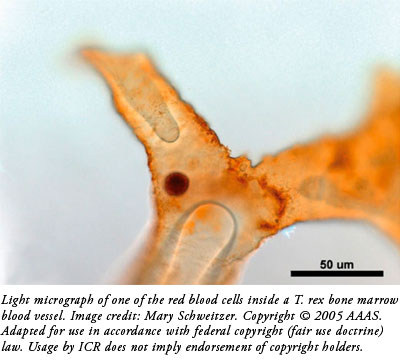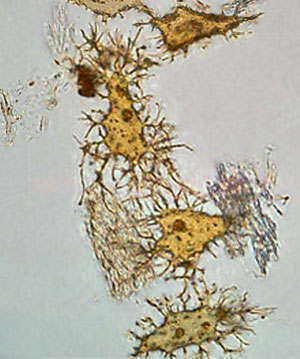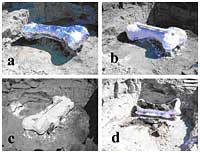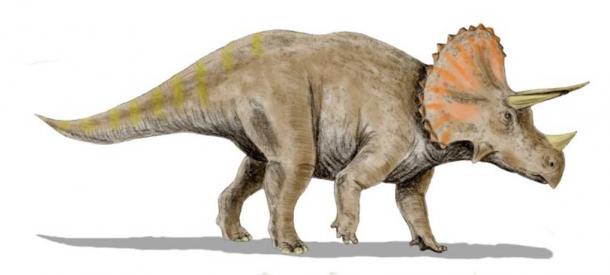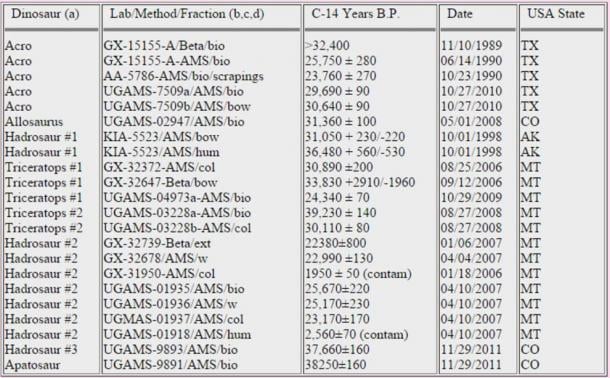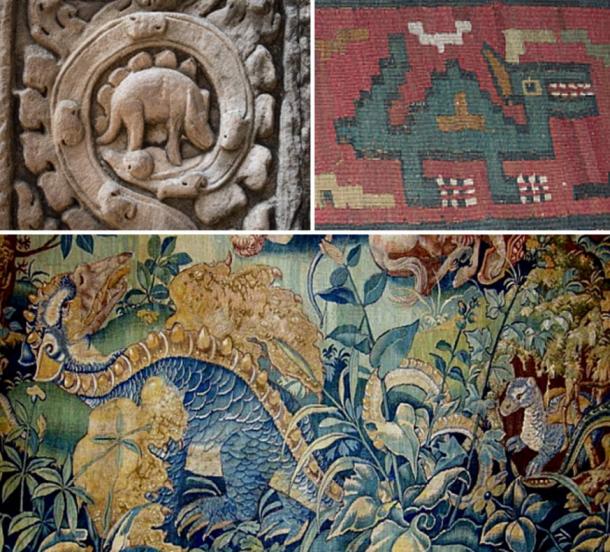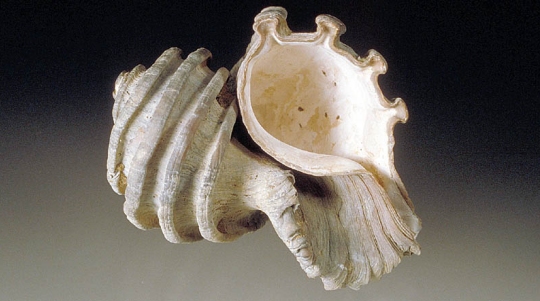Dr. Schweitzer identified 4 kinds of soft tissue and even critics have agreed there is soft tissue. ALL Darwinians blatantly deny the known laws of science in this area and in many other areas. ALL. ALL. ALL.
Schweitzer even found evidence of degraded hemoglobin fragments and structures that might represent altered blood remnants. See videos by the actual researchers here as well as some of the soft tissue:
At one point Dr. Schweitzer remembers, "The lab filled with murmurs of amazement, for I had focused on something inside the vessels that none of us had ever noticed before: tiny round objects, translucent red with a dark center. Then a colleague took one look at them and shouted, You've got red blood cells. You've got red blood cells!'. It was exactly like looking at a slice of modern bone. But, of course, I couldn’t believe it. I said to the lab technician: 'The bones, after all, are 65 million years old. How could blood cells survive that long?'"
Not only did they have blood vessels and structures that numerous tests have confirmed have the traits of red blood cells, during microscopic examination, they also fond that some portions of the long bones had not mineralized, but were in fact original bone.
Dr. Mary Schweitzer, states, "When you think about it, the laws of chemistry, biology and and everything else we know, say it should be gone, it should be degraded completely."
(~6:30)
She published a paper on it showing four types of soft tissue in the fossils.
"Soft tissues and cell-like microstructures derived from skeletal elements of a well-preserved Tyrannosaurus rex (MOR 1125) were represented by four components in fragments of demineralized cortical and/or medullary bone: flexible and fibrous bone matrix; transparent, hollow and pliable blood vessels; intravascular material, including in some cases, structures morphologically reminiscent of vertebrate red blood cells; and osteocytes with intracellular contents and flexible filipodia.”Soft tissue and cellular preservation in vertebrate skeletal elements from the Cretaceous to the present, Mary Higby Schweitzer, Jennifer L. Wittmeyer, John R. Horner
Published 22 December 2007.DOI: 10.1098/rspb.2007.2000
Derrick Briggs, curator of invertebrate paleontology at the Peabody Museum at Yale University agrees saying, "Nobody was imagining that dinosaurs might have had preserved soft tissues… this was totally improbable….We have this clear understanding that part of all biological cycles involves decay. Nature's set up to break down that material and recycle it. So, it’s just improbable that those kinds of very delicate structures would survive, particularly for millions of years."
He’s also agreeing that nothing we can verify with science would allow soft tissue to last for millions of years. Unfortunately, none of these evolutionists are considering that the millions of years dates for the dino fossils could be wrong. That concept is one which is not allowed to be wrong no matter how much evidence comes against it. Everything else can be wrong, including everything we know about science...but evolution and it's claims can't possibly be wrong.
Many researchers agree that this conflicts with everything we know about the processes of science.
"I mean can you imagine pulling a bone out the ground after 68 million years and then getting intact protein sequences?" said John Asara of Beth Israel Deaconess Medical Center and Harvard Medical School, lead author of one of the studies. "That's just mind boggling how much preservation there is in these bones."
Leading evolution experts on a NOVA program agree that nothing in science would make it possible for soft tissue to last more than ~100,000 years:
The new finding will be viewed skeptically, admitted one of the researchers involved in the two studies. "It's very, very, very controversial because most people have gone on record saying there's an absolute time limit to anything that's protein or DNA," said Mary Schweitzer, a molecular paleontologist at North Carolina State University.
Matthew Carrano, a dinosaur curator at the Smithsonian Institution in Washington, D.C., who was not involved in either study, said the protein findings are robust. "Here are the pieces of the protein. If you're going to refute this you have to explain how these pieces got in there," Carrano said in a telephone interview. "It's not another molecule mimicking the protein and giving off a similar signal. This is the actual sequence."
Jeanna Bryner, T. Rex Related to Chickens, LiveScience (http://news.yahoo.com/.../sc.../trexrelatedtochickens) See also: Sharon Begley, T. Rex and His Family, Newsweek, April 23, 2007
http://www.detectingdesign.com/fossilizeddna.html
Are there more cases of soft tissues in fossils?
1) As. Dr. Schweitzer said, she used a new technique with acid to remove bones that almost no one had used before. If more used that method, we'd find more soft tissue in fossils. Dr. Kaye tried to replicate Dr. Schweitzer and found a very large amount of soft tissue with her technique just like she did.
2) There actually are quite a number of other soft tissue finds.
A) Soft tissue in fossilized salamandar.
http://creation.com/muscle-and-blood-in-fossil
http://www.physorg.com/news176660912.html
B) DNA extracted from bacteria that are supposed to be 425 million years old brings into question that age, because DNA could not last more than thousands of years.
http://creation.com/article/419
C) http://creation.com/a-165-million-year-surprise
D) Salty Saga
http://www.answersingenesis.org/crea.../v23/i4/saltysaga.asp
E) In addition, we have much evidence that dinos lived with man:
https://www.youtube.com/playlist?p=PL648C2EAD205F397C (videos 4-20)
RESEARCH PAPERS BY SCHWEITZER
***Soft tissue and cellular preservation in vertebrate skeletal elements from the Cretaceous to the present
http://www.ncbi.nlm.nih.gov/pmc/articles/PMC1685849/
***Soft-Tissue Vessels and Cellular Preservation in Tyrannosaurus rex
http://www.sciencemag.org/content/307/5717/1952.abstract
**Schweitzer MH, Wittmeyer JL, Horner JR. 2007. Soft tissue and cellular preservation in vertebrate skeletal elements from the Cretaceous to the present. Proc. R. Soc. Lond. B. 274:183-187; 2. Schweitzer MH, Suo Z, Avci R, Asara JM, Allen MA, Teran Arce F, Horner JR. 2007.
**Analyses of soft tissue from Tyrannosaurus rex suggest the presence of protein. Science 316: 277-280; 3. Mary H. Schweitzer et al. 2005.
**Soft-Tissue Vessels and Cellular Preservation in Tyrannosaurus rex. Science. 307: 1952 - 1955.)
** W.I. Stanton, 'Wootton Bassett: fame at last for mud springs', Geology Today, 11(5):172, September--October, 1995. M. McNamara, P. Orr, S.L. Kearns, L. Alcalá, P. Anadón and E. Peñalver-Mollá,
**'Organic preservation of fossil musculature with ultracellular detail', Proceedings of the Royal Society B, published online before print 14 October 2009.
***See also: Schweitzer and Horner 1999; Schweitzer and Staedter 1997; Schweitzer et al. 1997a, 1997b.
http://www.meas.ncsu.edu/faculty/schweitzer/schweitzer.html
Remember that Dr. Schweitzer says she found 4+ different types of soft tissues and says, "It looks like blood vessels and it looks like bone matrix and it certain looks like cells and it acts like cells". She affirms that she has observed capillary structures and vessels. She says that they can take vessels and squeeze them out into solutions. She has only the slightest of reservations that they need to do some chemical analysis to be 100% sure. But, her attitude throughout the video is that she's 98% certain it's soft tissue, cells, capillaries and vessels and she has NO CLUE how to explain this happening and it flies in the face of all science she knows of (of course referring to evolution science). But, if it smells like a duck, looks like a duck, acts like a duck...well you know the conclusion.
Dr. Kaye subsequently published a paper calling Dr. Schweitzers findings just biofilm. Near the beginning of his page, he says this:
"Four categories of tissues were initially discovered in 2005 [1]: (A) Clusters of spheres that showed an iron-oxygen elemental signature appeared red under the light microscope. (B) Soft, branching, tube-like structures that contained spheres. (C) Free floating osteocytes complete with fillapodia and (D) a filamentous mass that remained pliable and elastic. Subsequent tests using immunochemistry showed positive for proteins [3]. Three of these structures were found commonly in this survey and discussed below."
http://www.plosone.org/article/info%3Adoi%2F10.1371%2Fjournal.pone.0002808
He goes on to argue that the soft tissue Dr. Schweitzer had found was not really soft tissue. It was just biofilm that had replaced the soft tissue and appeared to be soft tissue but was actually biofilm.
But, note the REASON why Kaye "found" biofilm.He was looking for soft tissue like Schweitzer found and found so much of it that he felt it couldn't match evolution.: "But as Kaye examined more fossils, he was puzzled to find similar materials in nearly every bone. Unable to reconcile the notion that so much tissue could have survived for millions of years, he turned to Zbigniew Sawlowicz {who told him it must be biofilm}." http://bacteriality.com/2008/08/26/dino/
He's basically saying that the soft tissue was contradicting evolution and since evolution can't be wrong it was impossible for what he found to be soft tissue in fossils, no matter how good the evidence is. This is a very strong case of bias if I’ve ever seen it.
Dr. Schweitzer points out numerous flaws in Dr. Kaye’s dissent.
"The idea that biofilms are completely and solely responsible for the origin or source of the structures we reported is not supported," she said by e-mail from a dinosaur dig in Montana. Microscopic views of bones can't explain why the fossil tissues reacted to the immune cells of chickens, for example, and the mammoth ones reacted with elephant cells, she says.
“There really isn’t a lot new here, although I really welcome that SOMEone is attempting to look at and repeat the studies we conducted. There are really several errors in wording (and spelling and grammar) in the paper by Kaye et al. that seem to underlie a fundamental misunderstanding of our work, our data and our interpretations.
“Something that is not fully appreciated by the outsider is that science is a process. One makes an observation, forms a testable hypothesis about the observation, gathers data, and the data either support or refute the hypothesis. It is then refined and retested. If the hypothesis is tested multiple times, it is strengthened, and eventually moves to become a theory, one of the strongest statements in science.
“If one chooses to challenge a hypothesis and the data put forth by another researcher to support it, one is under the obligation to
1. form a hypothesis that provides an alternative to the first;
2. reinterpret the original data presented in such a way that it __better supports__ the new hypothesis than the original, and
3. produce new data that, in addition to the original, more strongly supports the alternative hypothesis than the original. That is the progression of science. Hypotheses are continually being reformulated in this way, because science IS a process, and undergoes revision as new data become available.
http://scintilla.nature.com/node/380683
“While Kaye et al. address the morphology of the structures we observed, and find their own explanations for these, they do not address the considerable chemical and molecular data we put forth to support our hypothesis of endogeneity. We did propose biofilm production as a possible explanation for the material that we see, but we determined that based upon the data we had, microbial biofilms were not a parsimonious explanation for the data (see Schweitzer et al., 2007, Proc. R. Soc. Lond. B)...there is no evidence in the literature that biofilms form branching _hollow_ tubes as we observe...Kaye et al...do not identify microbial bodies, a hallmark of biofilm....Kaye et al. did not address our immunological data, and controls. They did not address the phylogenetic analyses of sequence as reported by Organ et al., 2008...Nor did they explain the internal, or ‘intracellular’ structure we report for observed osteocytes…
“And finally, they did not state how the rounded structures we reported could persist /_free floating_/ in a hollow biofilm…the structures we observed did not exhibit the microcryst structure know to characterize framboids…We continue to test the hypothesis that original material is retained in fossil bone… While we welcome the skepticism of colleagues, we hope that the reviewers and readers hold them to the standards to which we are held.
http://blogs.discovermagazine.com/loom/2008/08/01/slime-versus-dinosaur/
http://scintilla.nature.com/node/380683
You can read more about the immunological response here:
http://naturalselection.0catch.com/Files/fossilrecord.html#Dinosaur
Kaye acknowledges his study does not refute the immune responses reported by Schweitzer's team. "They have single handedly pioneered the use of sophisticated chemical analysis and have created a critical bridge between biology and paleontology," he says.
http://usatoday30.usatoday.com/tech/science/2008-07-29-fossils_N.htm
There’s another interesting point here. It is reported that Dr. Mary Schweitzer has refused to do C14 dating on the fossils because they might show a far younger age than evolution predicts. But, Dr. Kaye did. “In order to determine if the mineralized biofilms were ancient in origin, a sample of material removed from the vascular canals was subjected to 14C dating. The results were ‘greater than modern’ indicating a modern origin for the material.”
http://journals.plos.org/plosone/article?id=10.1371/journal.pone.0002808
I wonder if he just might be right on that part after all given how there is no scientific process that can explain soft tissue lasting more than 100,000 years (and some say as little as 15,000 years…note that both of these dates are also based on evolution assumptions.). I wonder if we should follow scientific processes and the weight of evidence that points to a young age for life in so many ways or just continue having faith in Darwin’s speculations that consistently keep getting debunked by real science. I really wonder.
One more from Dr. Schweitzer's paper (and there are many more verifications of soft tissue all over the fossil record..which shows that either Chris has no clue about how to read a scientific paper at all...or he's lying).
---
The presence of soft tissues and apparent cells in 68 Ma dinosaur bone (Schweitzer et al. 2005a) was unexpected, particularly because these components retain both morphological and some functional characteristics of their original state...
(about a mammoth) These structures vary in diameter, but in morphology and location, they are consistent with mammalian red blood cells...
Some vessels remained within fibrous matrix, and round red microstructures with opaque central regions (figure 3c) similar to those previously reported (Schweitzer et al. 1997a,b; Schweitzer & Horner 1999) were observed within. Flexible vessels were not as transparent as in other specimens, but were populated with uniformly oval, red-pigmented, translucent microstructures with opaque central cores...
Dense, round microstructures, tentatively correlated with intravascular microstructures observed under transmitted light and reported earlier (figure 3p; Schweitzer et al. 2005a), were isolated to vessel spaces within the demineralized matrix. The highly fragmented vessels contained small round red microstructures (figure 3s). This study addresses the following questions: (i) how extensive is preservation of soft tissues and cells in vertebrate remains, (ii) can patterns be discerned regarding tissue/cell degradation over time...
We tested many specimens of different geological ages (Recent, Pleistocene, Pliocene, Miocene, Cretaceous, Triassic), depositional settings (fluvial sandstone, cave deposits, loess, siltstone, mudstone, marine) and taxonomic affinity (birds, mammals, saurischian (theropod) and ornithischian (hadrosaur, ceratopsian) dinosaurs, and dicynodont) for the presence of flexible, fibrous matrix, hollow, transparent vessels, osteocytes and intravascular material. Some or all of the four elements first reported for three specimens of Tyrannosaurus rex (MOR 1125, FMNH-PR-2081, MOR 555) and Brachylophosaurus canadensis (MOR 794) (Schweitzer et al. 2005a), have now been identified in numerous fossil specimens from thousands to millions of years old
The above are from:
Soft tissue and cellular preservation in vertebrate skeletal elements from the Cretaceous to the present
www.ncbi.nlm.nih.gov/pmc/articles/PMC1685849/
Removal of the mineral phase reveals transparent, flexible, hollow blood vessels containing small round microstructures that can be expressed from the vessels into solution.
www.sciencemag.org/content/307/5717/1952.abstract
Death of Darwinism
soft tissue: osteocytes are ‘dead ringers’ for those present in living vertebrates Cameron J Tsujita
Last edited by Admin on Fri Oct 16, 2015 9:55 am; edited 1 time in total



